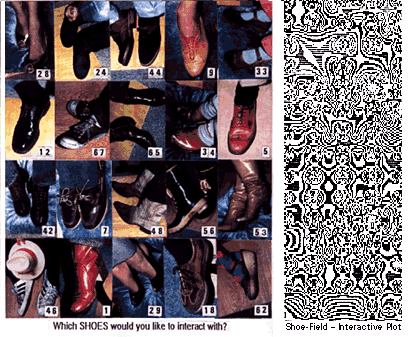

Shoe-Field is an interactive installation representing people's
feelings
about their shoes and their interaction with other people's shoes.
Shoe-Field was installed at MEDIA in San Francisco in 1986.
Documentation of
Rapoport's
first shoe event, A Shoe-In,1982, served as backdrop. Most visible
was an enlarged computer-generated field map rolled out on a 17 foot
ramp.
It represented the interaction of 76 people and their shoes. This
field-map,
a plotted composite of quantified shoe information from A
Shoe-In,
consisted of: answers to shoe questions, choice of foot rest and foot
position
while the shoes were photographed, the participants position in line
(they
were given numbers), and, lastly, interviews about their shoes. The data
was computed in an electric field theory program that created this
topographical-like
force field map composed of numbers and letters. In reading this map the
76 shoe energy charges and the affect they had upon each other could be
discerned. The shoe responses had been responsible for altering the
artwork
graphically.
The "real time" field in the interactive installation at MEDIA
consisted of a floor covered with black 2' x 2' tiles. These tiles had
been
imprinted in white ink with five different patterns that were the basic
designs for the energy levels before they became interactive. At the
entrance
to the installation participants were asked to take off their shoes and
to place them on the floor tile whose pattern resembled the printout they
had received from answering shoe questions on the computer.
The shoes on the tile were photographed and placed in the shoe bag pocket
reserved for photos of shoes carrying the same energy charge. Next,
participants
selected a pair of shoes from among the slides of shoes from the
earlierShoe-In
that they would most like to interact with. This time, an interactive
plot
pattern emerged from the printer after the slide number and their own
shoe
number were entered into a second computer. In addition to the printout
of an interactive podiatric Rorschark, the participants at the Tish
Center,
New York University, 1988; the Richmond Art Center, 1989; and the Capp
Street
Project, 1996, received a shoe psyche reading.
John Watkins was the computer design engineer.